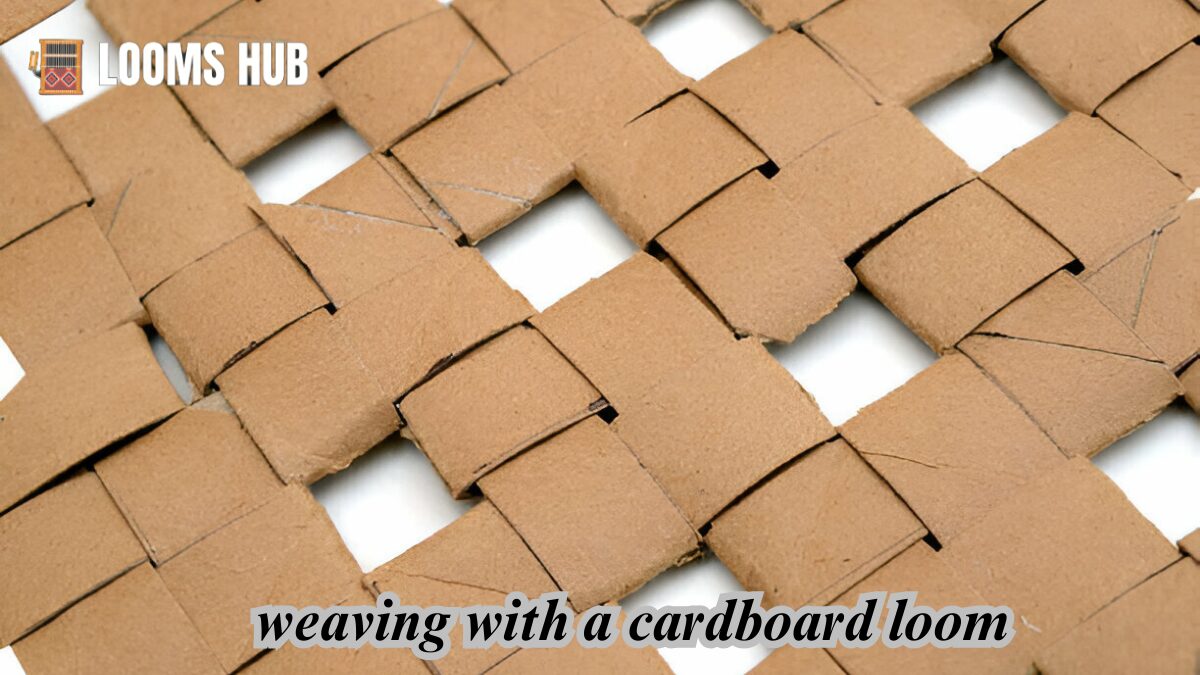Weaving with a cardboard has been a cherished craft for centuries, offering endless possibilities for creativity. Among the many tools used for weaving, the cardboard loom stands out as an accessible and affordable option, especially for beginners. In this comprehensive guide, we’ll delve into everything you need to know about weaving with a cardboard loom, from creating your loom to advanced techniques for stunning projects.
Whether you’re a novice or an experienced weaver looking for a portable solution, this guide has you covered. Let’s explore the wonderful world of cardboard loom weaving and unleash your inner artisan.
What is a Cardboard Loom?
A cardboard loom is a simple weaving tool made from a sturdy piece of cardboard with notches cut along two opposite edges. It serves as a frame to hold your warp threads in place while you weave.
Benefits of a Cardboard Loo
- Affordability: Perfect for budget-conscious crafters.
- Accessibility: Easy to make at home with minimal materials.
- Portability: Lightweight and convenient for on-the-go crafting.
- Versatility: Suitable for creating various projects like wall hangings, coasters, and small rugs.
Materials You Need for Cardboard Loom Weaving
To get started, gather these essential materials:
| Material | Purpose |
| Sturdy cardboard | Acts as the base for the loom. |
| Ruler and pencil | For measuring and marking notches. |
| Scissors or craft knife | Cut the cardboard and notches. |
| Yarn or thread | Used for both the warp and weft. |
| Tapestry needle | Helps weave the yarn through the warp. |
| Comb or fork | Packs down the weft for a tight weave. |
Optional materials include:
- A shuttle for holding your weft yarn.
- Decorative embellishments like beads or ribbons.
How to Make a Cardboard Loom
Crafting a cardboard loom is straightforward and fun. Follow these steps:
Step 1: Choose the Right Cardboard
Select a thick and sturdy piece of cardboard, such as the kind used for shipping boxes. The size depends on your desired project dimensions.
Step 2: Mark the Notches
Using a ruler and pencil, draw evenly spaced marks along the top and bottom edges of the cardboard. A spacing of 0.5 cm to 1 cm works well for most projects.
Step 3: Cut the Notches
Carefully cut small slits at each marked point. Ensure the notches are deep enough to hold the warp threads securely.
Step 4: Add Warp Threads
Anchor the warp threads by looping them around the notches from top to bottom, creating consistent tension. Tie the loose ends securely at the back of the loom.
Basic Weaving Techniques
Setting Up Your Warp
The warp threads form the vertical foundation of your weaving. Ensure they are evenly spaced and taut.
Adding the Weft
The weft is the horizontal thread woven over and under the warp threads. Here’s how to start:
- Thread your tapestry needle with the weft yarn.
- Begin at one side and alternate going over and under the warp threads.
- On the return pass, reverse the pattern to create a simple weave.
Packing the Weft
Use a comb or fork to gently push the weft down after each row, ensuring a tight and even weave.
Here’s the chart with a heading included:
Weaving with a Cardboard Loom: Key Information
| Aspect | Details |
| Tool | Cardboard loom (a homemade loom made from cardboard with notches) |
| Materials Needed | Cardboard, yarn, thread, scissors, craft knife (optional) |
| Skill Level | Beginner to intermediate |
| Best for | Beginners, kids, eco-friendly crafters, small projects |
| Common Projects | Small mats, bookmarks, coasters, wall hangings, scarves, bags |
| Warping Process | Tie yarn at the bottom, weave through notches, ensure even tension |
| Weaving Process | Pass weft thread over and under warp threads, repeat for each row |
| Benefits | Affordable, eco-friendly, develop creativity and fine motor skills |
| Age Group | Suitable for all ages, especially kids and beginners |
| Time to Complete | Varies from a few hours to several days depending on the project size |
Creative Weaving Patterns
Once you’ve mastered the basics, experiment with these patterns:
Tabby Weave
The simplest pattern involves a basic over-and-under motion.
Twill Weave
Achieve diagonal patterns by altering the sequence of over-and-under.
Rya Knots
Create texture by tying rya knots for a fringe effect.
Soumak Stitch
Add a braided look by wrapping the weft around each warp thread.
Project Ideas
Wall Hangings
Combine textures, colors, and patterns to create stunning decor.
Coasters
Weave small squares for functional and decorative coasters.
Mini Rugs
Use thicker yarns to craft tiny rugs for dollhouses or displays.
Bookmarks
Opt for thin yarns and a compact loom to create unique bookmarks.
Tips for Success
- Maintain Consistent Tension: Loose warp threads can ruin your design.
- Experiment with Materials: Mix yarn types for varied textures.
- Plan Your Design: Sketch a rough outline of your project before starting.
Case Study: A Beginner’s Journey
Sarah’s Story: Sarah, a high school student, wanted an affordable way to explore weaving. She started with a DIY cardboard loom and quickly advanced to creating intricate wall hangings. By mixing natural fibers with colorful threads, she developed a unique style. Sarah’s hobby eventually turned into a small Etsy business, showcasing the potential of starting simple.
Common Mistakes and How to Avoid Them
| Mistake | Solution |
| Uneven tension | Regularly adjust and check your warp threads. |
| Overpacking the weft | Use gentle pressure with your comb or fork. |
| Skipping warp threads | Double-check each row as you weave. |
Conclusion
Weaving with a cardboard loom is an enjoyable and rewarding craft that anyone can try. From its affordability to its creative potential, it’s the perfect starting point for aspiring weavers. Armed with this guide, you’re ready to embark on your weaving journey. Start small, experiment boldly, and most importantly, have fun!
FAQs
What is a cardboard loom?
A cardboard loom is a simple, DIY weaving tool made from cardboard, used for weaving yarn or thread into textiles. It’s an affordable and beginner-friendly alternative to traditional wooden looms.
How do I make a cardboard loom?
To make a cardboard loom, cut a rectangular piece of cardboard and create slits along both sides for the warp threads. Add a horizontal row of notches at the top and bottom for securing your weft threads.
What materials can I use for weaving on a cardboard loom?
You can use yarn, thread, fabric strips, or even paper for weaving. The choice of material depends on the texture and thickness you want for your project.
Can I weave complex patterns on a cardboard loom?
Yes! While cardboard looms are simple, you can still create intricate patterns by adjusting the color and texture of your yarn and using different weaving techniques like plain weave, twill, or basket weave.
Is weaving with a cardboard loom suitable for beginners?
Absolutely! Cardboard looms are perfect for beginners because they are inexpensive and easy to use, allowing you to practice basic weaving skills before moving on to more advanced techniques.
How long does it take to complete a weaving project on a cardboard loom?
The time it takes to complete a project depends on the size and complexity of the design. Small projects like bookmarks or coasters might take a few hours, while larger projects like wall hangings or scarves could take days or even weeks.
Can I use a cardboard loom for larger projects?
Yes, you can use a cardboard loom for larger projects, but you may need to make a bigger loom or multiple looms to accommodate the size of the fabric you want to weave.
How do I finish my weaving on a cardboard loom?
Once you’ve completed your weaving, carefully remove it from the loom, tie off the warp threads, and secure the ends. You can then trim the edges or add fringe for a polished look.
What are some common mistakes to avoid when weaving with a cardboard loom?
Common mistakes include uneven tension of the warp threads, inconsistent weaving, or not securing the ends of the threads properly. Ensure you keep the threads taut and even throughout the process for the best results.



